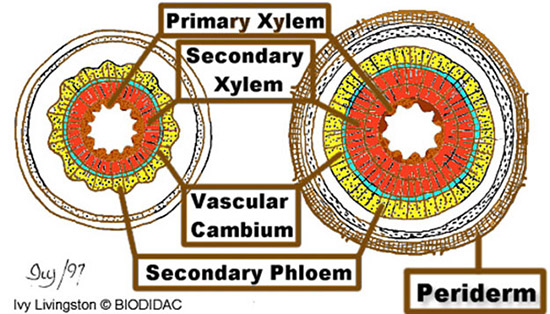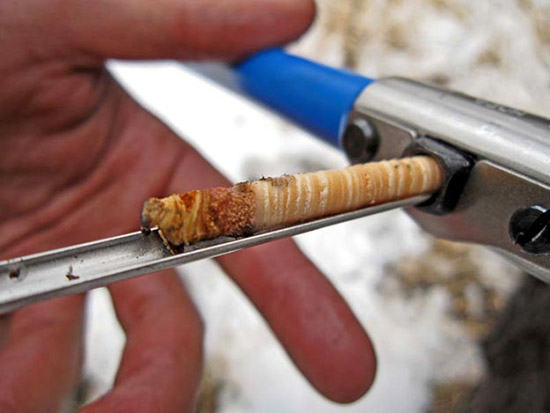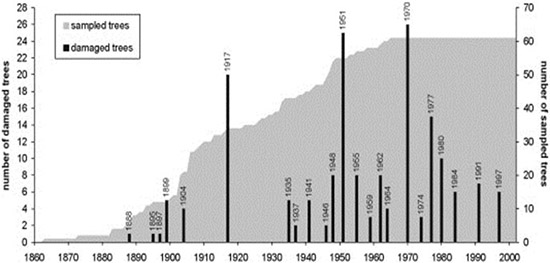Geology and Natural Heritage of the Long Valley Caldera
Dendrochronology: Looking Through a 5mm Window of the Past to Predict the Future
Andy Burnside
Abstract
The practice of dendrochronology has been a source for dating tree for many years. This docile data has provided interesting information to the biological academic community, but it has done little else for the remaining general public. The bristlecone pines of Eastern California became an iconic mark as a natural wonder of the west, but this still did very little to serve the general public. This has all changed in recent years as advancements in the analytical process of dendrology has been able to reveal climatic and major geologic events within a given tree’s lifespan. Scientists can now see catastrophic trends of climate change throughout the world that date back thousands of years. The interpretive techniques are still improving, but they currently serve as building blocks for an accurate assessment of what is to come.
Introduction
Trees have held a unique ecological niche over the last 385 million years. While its role within ecosystems has changed throughout this time, the majority of human civilizations have focused on domestic and industrial uses of this resource. Shelter and warmth alone have established wood as a cardinal commodity, but recent scientific advancements have unmasked these vascular wonders of nature as commensalists of life throughout the entire planet! These photosynthesizing pillars of the outdoors play a pivotal role in the persistence of countless ecological systems as respirators of air and agents in multiple nutrient cycles.
The biotic relationship between trees and various other organisms has a colorful story of its own, but recent experimentation and analysis have unveiled a whole new way of utilizing these natural resources. The support trees provide for ecosystems has been apparent for hundreds of years, but recent research has revealed how abiotic factors affect the prosperity of their development. It is through this mechanism of trunk augmentation that scientists are able to take a glimpse into nature’s photo album of prominent geologic and climactic events. These can detect volcanic activity, major earthquakes, glacial movement, annual precipitation, fire frequencies, and drastic climate fluctuations in an area.
Many trees in temperate climates will go through periods of rapid growth that is associated with increased sunlight, greater water supply, and increased nutrient uptake. Inversely, growth declines over winter months and trees shed unnecessary cells within its vascular system at times of limited resources. This cycle produces alternating shades of wood that appear in ring formations around the tree revealing its specific growth on an annual basis. The analysis utilizes variating growth patterns within each tree to determine the most salient natural events of a given year. An untrained eye would undoubtedly simplify the results as ample or scarce, but various factors within the color of rings, scars produced, and geomorphic measurements reveal more information about an area’s climate trends or sudden geologic events. Many foresters and scientists used the practice of dendrochronology, the technique of dating environmental changes and events with tree dating, to examine ecosystem alterations and cross-match events in an area.
Meteorologic measurements provide extremely specific information pertaining to this area of study, but this is limited to the past 200 years, and most measurements have been primarily in industrialized areas of the world. The park rangers, researchers, and select private industries had moderate knowledge of the local trees and climatology throughout the early twentieth century, but the full public emergence and advancement of dendrochronology did not truly spring until the 1950’s as the astounding age of bristlecone pine trees, Pinus longaeva, were revealed and more funding was emerged. The Sequoias of Western California provided useful information about fire trends, but bristlecones revealed much more about the climate and geomorphic alterations due to the sensitive nature of their growth and longevity. These contorted conifers have persisted through some of the harshest conditions a plant can face and now reveal up to 8000 years of information.
Dendrochronology
The field of dendrochronology can seem intimidating at first as it involves an interdisciplinary approach to relatively recent advancements in science. The biological and chemical aspects dig quite deep into the physiology of woody plants, but the central theme surrounds a plant’s physical response when expanding oneself. This is simply a mechanism to allow room for growth and support of its increasing biomass (Simpson, 129–130). This growth produces the rings that ultimately fluctuate based on the productivity of the tree throughout the year. The technical explanation of the process digs into plant physiology which has tedious terminology, but it provides a thorough insight into the natural process that opens the window for individuals to make interpretations about climate trends and geological events of the past (Ferguson et al, 843). Figure 1 represents the cross–section of a vascular plant and the common sections one might see inside.

Figure 1 (Ferguson et al, 843)
After the initial vertical extension from the ground, the tree must tangentially expand to support future biomass and adequately be able to transport nutrients. The xylem, primary transporter of water, and phloem, primary transporter of nutrients, indefinitely multiply mitotically at a rate that is determined by the specific organism’s CO2and sugar intake. The secondary cells of the xylem on the inside portion of the tree core and phloem cells on the outside portion of the tree core results in the expansion of the vascular cambium which is what composes tree rings; this is displayed in figure 1 (Webb,1).Greater amounts of water intake relate to increased activity in the xylem, and subsequently the cell divides at an increased rate; a similar trend occurs with the phloem and nutrients processed through photosynthesis.
Every species has a limited growth capacity that is regulated by hormones and its specific genes, and these are the underlying factors that determine the size of tree and its internal components (Simpson, 130). A variety of mutations and environmental factors can alter this, but the majority of trees in temporal ecosystems grow by these principles. This is specifically modeled after woody plants taxonomic order Coniferale because these had the greatest impact on the field of dendrochronology, but the analysis also overlaps with the growth patterns of many other vascular plants.
The tree coring process is fairly simple, but care must be taken to hold a steady grip as one establishes a steady drilling area. It is best to choose a spot away from branches and angled towards the absolute center of the tree. The object should tangentially dissect each ring and pierce the core. It does not have to be perfect, but missing rings is similar to leaving data behind. This does not harm the tree in any permanent fashion, and the hole will eventually seal over.
The sampling should be done at a relatively low height to ensure all rings are counted. This is because the total rings decrease with height accommodating the geometry and weight of the tree. The size of the core sampler varies based on the tree chosen and the instrument itself separates into three parts. Most cores will not exceed 2cm in diameter, but the average core is roughly 5mm in diameter(Wiles et. Al, 262). Even though it is small, it provides plenty of information to make a thorough analysis. An image of a core extraction is listed below in image 1. This shows distinguished tree rings and how small the core sample is.

When A.E. Douglass, the first credited dendrochronologist, drilled into a Sequoia tree in 1911, he knew that the information from the rings somehow was related to climate trends. Even though this derived from the original purpose of his experiment which focused solely on sunlight, it was an intriguing question that could not be answered because of the lack of material to cross-date with (Schulman, 2). Radiometric dating was not nearly close to being an established practice in scientific studies, and limited meteorological data at the time made it difficult to find an objective comparative source. These are both currently considered reliable sources to use, and it can also work inversely to verify a carbon date or determine climate adjustments in unmonitored areas. As with most scientific studies, collection of multiple samples from an area can help reduce the error when analyzing results (Simpson, 231).
Bristlecone Pine Trees
Bristlecone pines are renowned for their astounding age and durability over thousands of years, but behind this tale of perseverance is a perfect set of conditions that allow for such an organism to thrive undisturbed throughout a long lifespan. The factors that originally established this community of conifers is unknown, but the circumstances of their longevity have been well studied. One of the leading disruptions of tree growth across the majority of ecosystems relate to biotic perturbation. Larger vertebrates such as woodpeckers or beavers will attract much attention with this topic, but they do not exert nearly as much damage as insects and various other arthropods. Entire communities of trees have been depleted by invertebrates using the wood as homes or sources of nutrition. The bristlecone pine has been able to persist for such a long time because the climate it grows in is too cold to sustain such life (Schulman, 2). These pines do not, and have not, had to exert any energy to animal defense through its existence.
Most organisms have a fairly confined ecological amplitude in which they can persist. They can handle a slight fluctuation in climate or low impact competition in the area, but extending too far results in death. Bristlecone pines have a similar boundary, but their borders are much narrower than the average tree. Their specific requirements for nutrients, cold weather, and reduced competition isolate them to very remote places in the world. They have solely been found at high elevations in areas that fit such a description. The elevation of 11,500 ft keeps the area persistently cool in summer months and extremely cold in the winter. The trees are well adapted to this setting, but the slightest environmental fluctuations could easily destroy a community. These fluctuations are not only apparent with core samples of the bristlecone pines. Trees at lower elevations have confirmed the trend, and the results are evident with the current snowpack. Research indicates that the treeline in the White Mountains of Eastern California has been increasing in elevation for more than a decade (Lamarche et al, 638). Another study has shown that the trees might be able to survive with compensation of greater amounts of water, but this is not likely to be a natural occurrence. Either way, the causes behind this climate adjustment have many different contributing factors, and the trend will no likely take a drastic turn any time soon.
The rising temperatures cause drastic issues for areas such as the White Mountains that are in the rain shadow of a greater range. The already low precipitation in the area prevents much of the local fauna from invading the areas where bristlecones live. The area in the White Mountains that has the oldest trees has an average annual precipitation of 12 inches per year. The frigid soil helps preserve some of the moisture in the ground, but few plants are capable of extracting this.
The bristlecone pines are able to do this, and it serves as a reserve of resources in times of extended drought. The frigid climate also contributes to a very slow biochemical process within the tree’s vascular system that far exceeds any other member of the plant community. Coniferous trees commonly have pine needles to allow photosynthesis at a slower rate, and these needles are kept for approximately 2–3 years. This is considered an elongated period considering the average deciduous tree will shed its leaves on an annual basis. Bristlecone pines will usually keep each needle for 20–30 years with some lasting as long as 50years (Ferguson, 843)! Molecular work has not found a way to transpose any of these extended life features yet, and this remains an open topic for researchers.
Each community of bristlecone pines has a unique soil composition that is fairly similar but relatively different in exact distribution. The soil in the White Mountains that supports the pine growth has high concentrations of dolomite that also contains quartzic sandstone, and granite. This water stability and nutritive intake is directly related to the local vegetation. The areas with high concentrations dolomite also have extremely sparse populations of ectomycorrhizal fungi (Bidartondo, 295).
The lack of fungi prevents other organisms from entering the zone of the bristlecone pines. The organisms need symbiotic mutualists to decompose organic material and transport them to the roots of plants. This chain reaction allows scarce vegetation to grow around the bristlecones which reduced the material that can catch spread wildfires to them. The valleys surrounding the bristlecone pine growth areas have a higher concentration of sandstone and granite which allows the fungi to persist. These areas are dominated by Sagebrush and have limited other biodiversity.
Dendrogeomorphology
Dendrogeomorphology utilizes tree core samples to analyze changes in an area over the lifespan of a tree. The age of the tree is pivotal as described earlier, but along with this is the range of the tree’s chronology holds an important role. Certain geographic features can hinder the span of certain tree populations, but the bristlecone pines in the White Mountains do not fall into this category. Their chronology reached from 1600km (994 miles) to the east and south, and it reached 480km north. This chronology spans through the "Spring Mountains, Panamint Mountains, Death Valley, the Inyo Mountains, and the southern portion of the White Mountains" (Wiley et al, 261).
The process of tree dating and comparing the results to environmental conditions relates back to the principle discussed earlier of how the specific geometric shape was established. The environment acts in a similar fashion as the water and nutrients determine growth, but usually only extreme cases of stunted development are noticeable. An example from this chronology in the White Mountains compares the area to a nearby region with slightly different glacial activity. The analysis indicated that a tree within 10 miles of a glacier has suppressed growth(Wiles et al, 263). This study examined glacial trends with the tree dating and provided adequate results.
Techniques for indentifying the morphological affects of debris fall on tree growth have occurred in the Valle de Gallo near the border between Italy and Switzerland. This involved sampling trees in nine different areas throughout the valley that is surrounded by alluvial fans. These areas were cored and analyzed for trends of similar growth patterns which can be seen in Figure 3.
The demonstrated scaring and damage matched several years of known debris flow with limited information about a specific date. The damage done to the trees was too significant to call the results completely successful, but this still proved to be a meaningful dendrogeomorphological experiment as the tree coring was able to indicate environmental events in the area within close proximity. It does not specifically pertain to the White Mountain’s geological structure with the bristlecone pines, but it does advance the field (Bollschweiler, 640). The results are depicted in Figure 3 below.

Figure 3 (Bollschweiler, (638)
Conclusion
The principles of Dendrochronology utilize James Hutton’s ideal of uniformitarianism when examining nature. The present gives clues to what happened in the past, but this is not the end of the road. The scientific world finally is able to obtain detailed information about annual climatic and geologic events, and this opens the door to understanding what will happen in the future. Studies of past trends can reveal events that are likely to come. Providing an exact date and time for these events may be asking for too much, but this can still reshape how to prepare for what’s next. Understanding the information and advancing it as far as possible can drastically change people’s perception of the climate to come.
Works Cited
Andrews, Sarah. Biology Online Diagram: Scribe Post 3/13/12. N.p., n.d. Web. 12 June 2012. website.
Bidartondo, B.I., J. Baar, and T.D. Bruns. Low Ectomycorrhizal Inoculum Potential and Diversity from Soils in and near Ancient Forests of Bristlecone Pine (Pinus Longaeva). NRC Research Press Web 79 (2000): 293-99. Print.
Bollschweiler, M., and M. Stoffel. Tree Rings and Debris Flows: Recent Developments, Future Directions. Progress in Physical Geography 34.5 (2010): 625–45. Print.
Connor, Kristina, and Ronald Lanner. Age-related Changes in Shoot Growth Components of Great Basin Bristlecone Pine. Canadian Journal of Forest Research 19.7 (1989): 933–35. Print.
Ferguson, C. W. Bristlecone Pine: Science and Esthetics: A 7100–year Tree–ring Chronology Aids Scientists; Old Trees Draw Visitors to California Mountains. Science 159.3817 (1968): 839–46. Print.
Griffin, Dan. Dan Griffin’s Biosphere 2 Blog. Dan Griffin's Biosphere 2 Blog. N.p., n.d. Web. 12 June 2012. website/.
Lamarche, V. Holocene Climatic Variations Inferred from Treeline Fluctuations in the White Mountains, California. Quaternary Research 3.4 (1973): 632–60. Print.
Lloyd, Andrea H., and Lisa J. Graumlich. Holocene Dynamics of Treeline Forests in the Sierra Nevada. Ecology 78.4 (1997): 1199. Print.
Peter, Brown, Hughes Malcolm, Baisan Christopher, Swetnam Thomas, and Caprio Anthony. Giant Sequoia Ring-Width Chronologies From the Central Sierra Nevad, California. Tree–Ring Bulletin 52 (1992): 1–14. Print.
Schulman, Edmund. Dendrochronology. Dendrochronology. N.p., 1995. Web. 12 June 2012. website.
Simpson, Michael G. Plant Systematics. 2nd ed. Amsterdam: Elsevier/Academic, 2006. Print.
Webb, David. BOT 201. BOT 201 and BOT 201 Lab. N.p., n.d. Web. 12 June 2012. website.
Wiles, Gregory, Calkin Parker, and Gordan Jacoby. Tree–ring Analysis and Quaternary Geology: Principles and Recent Applications. Geomorphology 16 (1996): 259–72. Print.
Wright, R.D., and H.A. Mooney. Substrate–oriented Distribution of Bristlecone Pine in the White Mountains of California. The American Midland Naturalist 73 (1965): 257–62. Print.